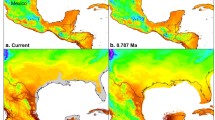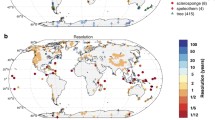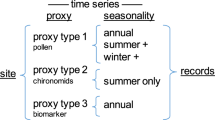Abstract
CLAMP Online is a new form-driven web facility enabling Climate Leaf Analysis Multivariate Program (CLAMP) palaeoclimate determinations to be conducted in their entirety without the need for additional software. This facility is demonstrated using physiognomic data from 82 Eocene to Pliocene fossil sites in North America, the Physg3brc CLAMP calibration file, and both locally derived climate data (Met3br) and 0.5° × 0.5° gridded climate data (GRIDMet3br). All the fossil sites fall within the physiognomic space defined by the Physg3brc dataset showing the versatility of this calibration for Paleogene to Present sites in North America. The fossil sites also plot in the mesic part of physiognomic space confirming that the source of the fossil material was vegetation growing under conditions where water was not growth-limiting to any significant degree. Regression equations are derived relating the local to the gridded climate predictions showing the relative predictive capabilities of each dataset, as well as offering ways to convert previously published data between the two calibrations. Palaeoclimate data (mean annual, warm month mean and cold month mean temperatures, growing season length, growing season and mean monthly growing season precipitation, precipitation during the three consecutive wettest and three consecutive driest months, and annual averages for relative and specific humidities and enthalpy) are given for all 82 sites.





















Similar content being viewed by others
References
Axelrod DI (1939) A Miocene flora from the western border of the Mohave Desert. Carnegie Inst Wash Publ 516:1–129
Axelrod DI (1944) The Sonoma flora. In: Chaney RW (ed) Pliocene floras of California and Oregon. Carnegie Inst Wash Publ 553:167–206
Axelrod DI (1950) The Anaverde flora of southern California. Carnegie Inst Wash Publ 590:119–158
Axelrod DI (1956) Mio-Pliocene floras from west-central Nevada. Univ Calif Publ Geol Sci 33:1–322
Axelrod DI (1964) The Miocene Trapper Creek flora of southern Idaho. Univ Calif Publ Geol Sci 51:1–161
Axelrod DI (1966) The Eocene Copper Basin flora of northeastern Nevada. Univ Calif Publ Geol Sci 59:1–125
Axelrod DI (1980) Contributions to the Neogene paleobotany of central California. Univ Calif Publ Geol Sci 121:1–212
Axelrod DI (1985) Miocene floras from the Middlegate basin, west-central Nevada. Univ Calif Publ Geol Sci 129:l–279
Axelrod DI (1991) The Early Miocene Buffalo Canyon Flora of Western Nevada. Univ Calif Publ Geol Sci 135:1–180
Axelrod DI (1992) The middle Miocene Pyramid flora of western Nevada. Univ Calif Publ Geol Sci 137:1–50
Benzecri JP (1973) L’analyse des données: L’analyse des correspondences. Dunod, Paris
Chaney RW (1920) The flora of the Eagle creek formation. Walker Mus Univ Chicago Contr 2:1–173
Chaney RW (1927) Geology and palaeontology of the Crooked River basin, with special reference to the Bridge Creek flora. Carnegie Inst Wash Publ 346:45–138
Chaney RW (1944) The Troutdale flora In: Chaney RW (ed) Pliocene floras of California and Oregon. Carnegie Inst Wash Publ 553:323–351
Chaney RW, Axelrod DI (1959) Miocene floras of the Columbia Plateau. Carnegie Inst Wash Publ 617:135–237
Chaney RW, Sanborn EI (1933) The Goshen flora of west-central Oregon. Carnegie Inst Wash Publ 439:1–103
Condit CB (1938) The San Pablo flora of west-central California. Carnegie Inst Wash Publ 476:219–268
Condit CB (1944a) The Remington Hill flora. In: Chaney RW (ed) Pliocene floras of California and Oregon. Carnegie Inst Wash Publ 553: 21–55
Condit CB (1944b) The Table Mountain flora. In: Chaney RW (ed) Pliocene floras of California and Oregon. Carnegie Inst Wash Publ 553:57–90
Craggs HJ (2005) Late Cretaceous climate signal of the Northern Pekulney Range Flora of northeastern Russia. Palaeogeogr Palaeoclimatol Palaeoecol 217:25–46
Herman AB, Spicer RA (1997) New quantitative palaeoclimate data for the Late Cretaceous Arctic: evidence for a warm polar ocean. Palaeogeogr Palaeoclimatol Palaeoecol 128:227–251
Hill MO (1973) Reciprocal Averaging: an eigenvector method of ordination. J Ecol 61:237–249
Hill MO (1974) Correspondence Analysis: a neglected multivariate method. Appl Stat 23:340–354
Jacques FMB, Tao S, Spicer RA, Xing Y, Huang Y, Wang W, Zhou Z (2011) Leaf physiognomy and climate: are monsoon systems different? Glob Planet Chang 76:56–62
Kovach WL, Spicer RA (1996) Canonical Correspondence Analysis of Leaf Physiognomy: A Contribution to the development of a new palaeoclimatological tool. Palaeoclimates 2:125–138
LaMotte RS (1936) The Upper Cedarville flora of northwestern Nevada and adjacent California. Carnegie Inst Wash Publ 455:57–142
Lakhanpal RN (1958) The Rujada flora of west central Oregon. Univ Calif Publ Geol Sci 35:1–65
MacGinitie HD (1933) The Trout Creek flora of southeastern Oregon. Carnegie Inst Wash Publ 416:21–68
MacGinitie HD (1937) The flora of the Weaverville beds of Trinity County, California. Carnegie Inst Wash Publ 455:83–151
MacGinitie HD (1941a) A middle Eocene flora from the central Sierra Nevada. Carnegie Inst Wash Publ 534:1–178
MacGinitie HD (1941b) Flora of Weaverville beds of Trinity County, California. Carnegie Inst Wash Publ 465:83–151
MacGinitie HD (1953) Fossil plants from the Florissant beds, Colorado. Carnegie Inst Wash Publ 599:1–198
MacGinitie HD (1969) The Eocene Green River flora of northwestern Colorado and northeastern Utah. Univ Calif Publ Geol Sci 83:1–140
MacGinitie HD (1974) An early middle Eocene flora from the Yellowstone-Absaroka volcanic province, northwestern Wind River Basin, Wyoming. Univ Calif Publ Geol Sci 108:1–103
New M, Hulme M, Jones P (1999) Representing twentieth-century space–time climate variability. Part I: Development of a 1961–90 mean monthly terrestrial climatology. J Clim 12:829–856
New M, Lister D, Hulme M, Makin J (2002) A high-resolution data set of surface climate over global land areas. Clim Res 21:1–25
Oksanen J, Blanchet FG, Kindt R, Legendre P, O'Hara RB, Simpson GL, Solymos P, Henry M, Stevens H, Wagner H (2010) vegan: Community Ecology Package. R package version 1:17–4
Oliver E (1934) A Miocene flora from the Blue Mountains, Oregon. Carnegie Inst Wash Publ 445:1–27
Potbury SS (1935) The La Porte flora of Plumas County, California. Carnegie Inst Wash Publ 465:29–81
Povey DAR, Spicer RA, England PC (1994) Palaeobotanical Investigation of early Tertiary Palaeoelevations in northeastern Nevada: Initial Results. Rev Palaeobot Palynol 81:1–10
R Development Core Team (2010) R: A language and environment for statistical computing. R Foundation for Statistical Computing, Vienna, Austria
Renney KM (1972) The Miocene Temblor flora of west central California. Dissertation, University of California
Sanborn EI (1935) The Comstock flora of west central Oregon. Carnegie Inst Wash Publ 465:1–28
Smiley CJ (1963) The Ellensburg Flora of Washington. Univ Calif Publ Geol Sci 35:159–267
Spicer RA (2000) Leaf physiognomy and climate change. In: Culver SJ, Rawson P, (ed) Biotic Response to Global change. The Last 145 Million Years. Cambridge University Press, Cambridge, pp 244–264
Spicer RA (2007) Recent and Future Developments of CLAMP: Building on the Legacy of Jack A Wolfe. Cour Forsch-Inst Senckenberg 258:109–118
Spicer RA (2008) CLAMP. In: Gornitz V (ed) Encycopedia of Paleoclimatology and Ancient Environments. Springer, Dordrecht, pp 156–158
Spicer RA, Herman AB (2010) The Late Cretaceous environment of the Arctic: A quantitative reassessment based on plant fossils. Palaeogeogr Palaeoclimatol Palaeoecol 295:423–442
Spicer RA, Herman AB, Kennedy EM (2004) Foliar Physiognomic Record of Climatic Conditions during Dormancy: Climate Leaf Analysis Multivariate Program (CLAMP) and the Cold Month Mean Temperature. J Geol 112:685–702
Spicer RA, Herman AB, Kennedy EM (2005) The Sensitivity of CLAMP to Taphonomic loss of Foliar Physiognomic Characters. Palaios 20:429–438
Spicer RA, Valdes PJ, Spicer TEV, Craggs HJ, Srivastava G, Mehrotra RC, Yang J (2009) New developments in CLAMP: calibration using global gridded meteorological data. Palaeogeogr Palaeoclimatol Palaeoecol 283:91–98
Spicer RA, Bera S, De Bera S, Spicer TEV, Srivastava S, Mehrotra R, Mehrotra N, Yang J (2011) Why do foliar physiognomic climate estimates sometimes differ from those observed? Insights from taphonomic information loss and a CLAMP case study from the Ganges Delta. Palaeogeogr Palaeoclimatol Palaeoecol 302:381–395
Stranks L, England P (1997) The use of a resemblance function in the measurement of climatic parameters from the physiognomy of woody dicotyledons. Palaeogeogr Palaeoclimatol Palaeoecol 131:15–28
ter Braak CJF (1986) Canonical correspondence Analysis: a new eigenvector technique for multivariate direct gradient analysis. Ecology 67:1167–1179
Teodoridis V, Mazouch P, Spicer RA, Uhl D (2011) Refining CLAMP - Investigations towards improving the Climate Leaf Analysis Multivariate Program. Palaeogeogr Palaeoclimatol Palaeoecol 299:39–48
Traiser C, Uhl D, Klotz S, Mosbrugger V (2007) Leaf physiognomy and palaeoenvironmental estimates – an alternative technique based on a European calibration. Acta Palaeobot 47:183–201
Wahrhaftig C, Wolfe JA, Leopold EB, Lanphere MA (1969) The coal-bearing group in the Nenana coal field, Alaska. US Geol Surv Bull 1274-D:1–30
Wolfe JA (1964) Miocene floras from Fingerrock Wash, southwestern Nevada. US Geol Surv Prof Pap 454-N:1–36
Wolfe JA (1993) A Method of Obtaining Climatic Parameters from Leaf Assemblages. US Geol Surv Bull 2040:1–73
Wolfe JA (1994a) Tertiary climatic changes at middle latitudes of western North America. Palaeogeogr Palaeoclimatol Palaeoecol 108:195–205
Wolfe JA (1994b) An analysis of Neogene climates in Beringia. Palaeogeog Palaeoclimatol Palaeoecol 108:207–216
Wolfe JA, Schorn HE (1990) Taxonomic revision of the Spermatopsida of the Oligocene Creede flora, Colorado. US Geol Surv Bull 1923:1–40
Wolfe JA, Spicer RA (1999) Fossil Leaf Character States:Multivariate Analysis. In: Jones TP, Rowe NP (eds) Fossil Plants and Spores: Modern Techniques. Geological Society, London, pp 233–239
Wolfe JA, Tanai T (1980) The Miocene Seldovia Point flora from the Kenai Group, Alaska. US Geol Surv Prof Pap 1105:1–52
Wolfe JA, Schorn HE, Forest CE, Molnar P (1997) Paleobotanical Evidence for High Altitudes in Nevada During the Miocene. Science 276:1672–1675
Wolfe JA, Forest CE, Molnar P (1998) Paleobotanical evidence of Eocene and Oligocene paleoaltitudes in midlatitude western North America. GSA Bull 110:664–678
Acknowledgements
We are of course indebted to the late Jack Wolfe for bequeathing R.A. Spicer the data and grateful for the constructive comments and criticism offered by Dieter Uhl and Elizabeth Kennedy during the preparation of this work for publication. R.A. Spicer was supported by the Chinese Academy of Sciences Visiting Professorship for Senior International Scientists at the Institute of Botany (2009S1-20) . This research was also supported by the International S & T Cooperation Project of China No. 2009DFA32210.
Author information
Authors and Affiliations
Corresponding author
Electronic supplementary materials
Below is the link to the electronic supplementary material, which includes the complete results files generated by the CLAMP Online analyses for both the gridded and local climate data.
ESM 1
(ZIP 575 kb)
ESM 2
(ZIP 578 kb)
ESM Fig. 1
(JPEG 79.5 KB)
Rights and permissions
About this article
Cite this article
Yang, J., Spicer, R.A., Spicer, T.E.V. et al. ‘CLAMP Online’: a new web-based palaeoclimate tool and its application to the terrestrial Paleogene and Neogene of North America. Palaeobio Palaeoenv 91, 163–183 (2011). https://doi.org/10.1007/s12549-011-0056-2
Received:
Revised:
Accepted:
Published:
Issue Date:
DOI: https://doi.org/10.1007/s12549-011-0056-2




